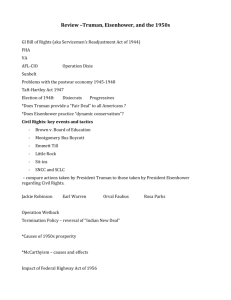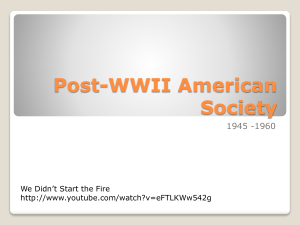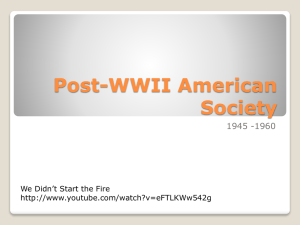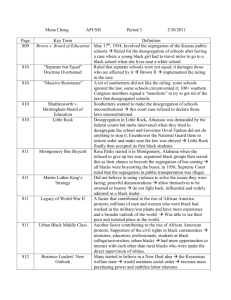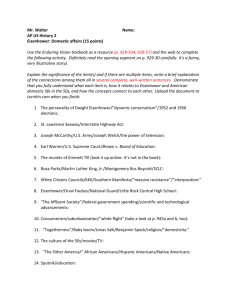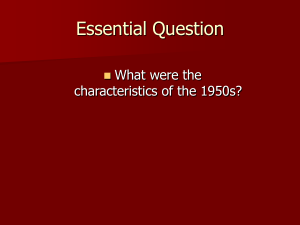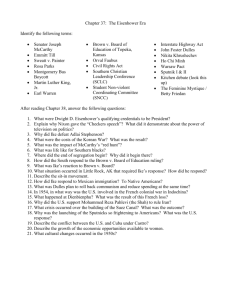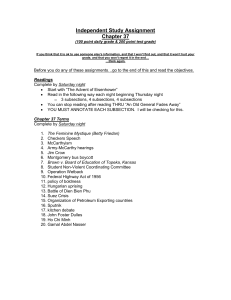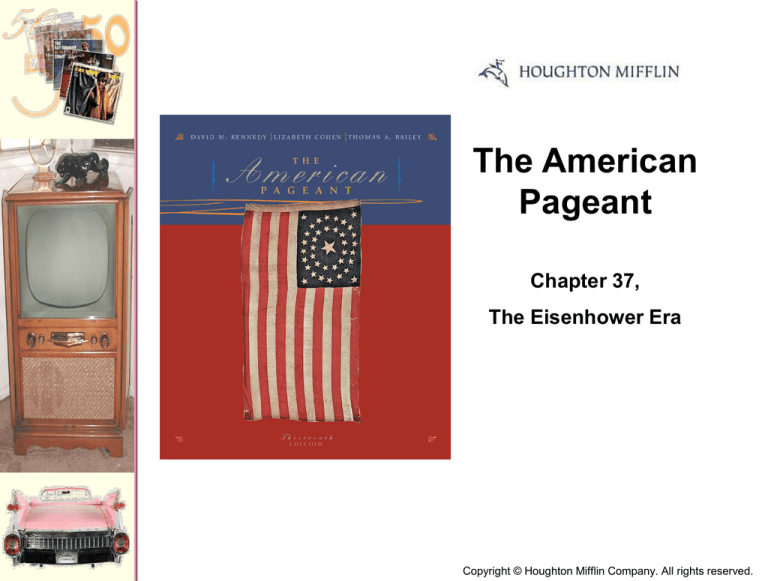
The American
Pageant
Chapter 37,
The Eisenhower Era
Copyright © Houghton Mifflin Company. All rights reserved.
THE 1950s:
“Conservatism, Complacency,
and Contentment”
OR
“Anxiety, Alienation, and
Social Unrest” ??
Adapted from Ms. Susan M. Pojer
Horace Greeley HS Chappaqua, NY
Warm-up
1. What do you see in this picture?
2. What do you know about life during
the 1950s because of this picture?
3. Who might have been excluded
from this lifestyle?
1A. Baby Boom
It seems to me that every other young
housewife I see is pregnant.
-- British visitor to America, 1958
1957 1 baby born every 7 seconds
1B. Baby Boom
Dr. Benjamin Spock
and the Anderson
Quintuplets
2A. Suburban Living
Levittown, L. I.:
“The American Dream”
1949 William Levitt produced
150 houses per week.
$7,990 or $60/month with no down payment.
2A. Suburban Living:
The New “American Dream”
k 1 story high
k 12’x19’ living room
k 2 bedrooms
k tiled bathroom
k garage
k small backyard
k front lawn
By 1960 1/3 of the U. S. population in
the suburbs.
Little Boxes by Malvina Reynolds
Little boxes on the hillside, •
Little boxes made of
tickytacky
Little boxes on the
hillside, little boxes all
the same
There's a green one
and a pink one and a
blue one and a yellow •
one
And they're all made
out of ticky tacky and
they all look just the
same.
And the people in the
houses all went to the
university
Where they were put in
boxes and they came
out all the same,
And there's doctors
and there's lawyers,
and business
executives
And they're all made
out of ticky tacky and
they all look just the
same.
And they all play on
the golf course and
drink their martinis
dry,
And they all have
pretty children and
the children go to
school
And the children go
to summer camp and
then to the university
Where they are put in
boxes and they come
out all the same.
And the boys go into
business and marry
and raise a family
In boxes made of
ticky tacky and they
all look just the same.
2B. Suburban Living
SHIFTS IN POPULATION
DISTRIBUTION,
1940-1970
Central Cities
Suburbs
Rural Areas/
Small Towns
1940
31.6%
19.5%
48.9%
1950
32.3%
23.8%
43.9%
U. S. Bureau of the Census.
1960
32.6%
30.7%
36.7%
1970
32.0%
41.6%
26.4%
2c. Suburban Living:
The Typical TV Suburban Families
The Donna
Reed Show
1958-1966
Father Knows Best
1954-1958
Leave It
to Beaver
1957-1963
The Ozzie & Harriet Show
1952-1966
Leave it to Beaver
4. What do you know about life during the
1950s because of this clip? Do you think it
is an accurate portrayal?
3a. Consumerism
1950 Introduction of the Diner’s Card
All babies were potential consumers who
spearheaded a brand-new market for food,
clothing, and shelter.
-- Life Magazine (May, 1958)
3B. Consumerism
4A. A Changing Workplace
Automation:
1947-1957 factory workers decreased by
4.3%, eliminating 1.5 million
blue-collar jobs.
By 1956 more white-collar than blue-collar
jobs in the U. S.
Computers Mark I (1944). First IBM
mainframe computer (1951).
Corporate Consolidation:
By 1960 600 corporations (1/2% of all
U. S. companies) accounted for
53% of total corporate income.
WHY?? Cold War military buildup.
4B. A Changing Workplace
New Corporate Culture:
“The Company Man”
1956 Sloan Wilson’s The Man in
the Gray Flannel Suit
5A. The Culture of the Car
Car registrations:
1945 25,000,000
1960 60,000,000
2-family cars doubles from 1951-1958
1958 Pink Cadillac
1959 Chevy Corvette
1956 Interstate Highway Act largest
public works project in American
history!
Å Cost $32 billion.
Å 41,000 miles of new highways built.
5B. The Culture of the Car
America became a more homogeneous
nation because of the automobile.
First McDonald’s
(1955)
Drive-In
Movies
Howard
Johnson’s
5C. The Culture of the Car
The U. S. population was on the move in the
1950s.
NE & Mid-W S & SW (“Sunbelt” states)
1955 Disneyland opened in Southern California.
(40% of the guests came from outside
California, most by car.)
Frontier Land
Main Street
Tomorrow Land
6A. Television
1946
1950
7,000 TV sets in the U. S.
50,000,000 TV sets in the U. S.
Television is a vast wasteland. Newton
Minnow, Chairman of the Federal
Communications Commission, 1961
Mass Audience TV celebrated traditional
American values.
Truth, Justice, and the American way!
6B. Television – The Western
Davy Crockett
King of the Wild Frontier
Sheriff Matt
Dillon, Gunsmoke
The Lone Ranger
(and his faithful
sidekick, Tonto):
Who is that masked man??
6C. Television - Family Shows
Glossy view of mostly
middle-class suburban life.
But...
I Love Lucy
Social Winners?...
The Honeymooners
AND…
Loosers?
Lucy, the first pregnant woman
When Lucy became pregnant in 1952 with her 2nd child, CBS
became nervous. The network worried about ratings & about
sponsorship for the show. Women weren’t portrayed as pregnant on
television. I Love Lucy broke this taboo by weaving Lucy’s
pregnancy into the storyline of the series. As a result, 44 million
viewers tuned in to the program in January 1953 to watch Lucy give
birth to Little Ricky. An amazing 72% of all U.S. homes with TV
watched this episode.
7A. Teen Culture
In the 1950s the word “teenager” entered
the American language.
By 1956 13 mil. teens with $7 bil. to spend
a year.
1951 “race music” “ROCK ‘N ROLL”
Elvis Presley “The King”
7B. Teen Culture
“Juvenile Delinquency”
???
1951 J. D. Salinger’s
A Catcher in the Rye
Marlon Brando in
The Wild One
(1953)
James Dean in
Rebel Without a
Cause (1955)
7C. Teen Culture
The “Beat” Generation:
f Jack Kerouac On The Road
f Allen Ginsberg poem, “Howl”
f Neal Cassady
f William S. Burroughs
“Beatnik”
“Clean” Teen
7D. Teen Culture
Behavioral Rules of the 1950s:
U Obey Authority.
U Control Your Emotions.
U Don’t Make Waves Fit in
with the Group.
U Don’t Even Think About Sex!!!
8A. Religious Revival
Today in the U. S., the Christian faith is back in
the center of things. -- Time magazine, 1954
Church membership: 1940
64,000,000
1960 114,000,000
Television Preachers:
1. Catholic Bishop Fulton J. Sheen “Life is
Worth Living”
2. Methodist Minister Norman Vincent Peale
The Power of Positive Thinking
3. Reverend Billy Graham ecumenical message;
warned against the evils of Communism.
9A. Well-Defined Gender Roles
The ideal modern woman married, cooked and
cared for her family, and kept herself busy by
joining the local PTA and leading a troop of
Campfire Girls. She entertained guests in her
family’s suburban house and worked out on the
trampoline to keep her size 12 figure.
-- Life magazine, 1956
Marilyn
Monroe
The ideal 1950s man was the provider, protector,
and the boss of the house. -- Life magazine, 1955
1956 William H. Whyte, Jr. The
Organization Man
A a middle-class, white suburban
male is the ideal.
8B. Religious Revival
Hollywood: apex of the biblical epics.
The Robe
1953
The Ten Commandments
1956
Ben Hur
1959
It’s un-American to be un-religious!
-- The Christian Century, 1954
9B. Well-Defined Gender Roles
Changing Sexual Behavior:
Alfred Kinsey:
1948 Sexual Behavior in the Human
Male
1953 Sexual Behavior in the Human
Female
v
v
Premarital sex was common.
Extramarital affairs were frequent
among married couples.
Kinsey’s results are an assault on the family
as a basic unit of society, a negation of moral
law, and a celebration of licentiousness.
-- Life magazine, early 1950s
10A. Progress Through Science
1951 -- First IBM Mainframe Computer
1952 -- Hydrogen Bomb Test
1953 -- DNA Structure Discovered
1954 -- Salk Vaccine Tested for Polio
1957 -- First Commercial U. S. Nuclear
Power Plant
1958 -- NASA Created
1959 -- Press Conference of the First 7
American Astronauts
10B. Progress Through Science
1957 Russians launch SPUTNIK I
1958 National Defense
Education Act
10C. Progress Through Science
UFO Sightings skyrocketed in the 1950s.
War of the
Worlds
Hollywood used aliens as a metaphor
for whom ??
10D. Progress Through Science
Atomic Anxieties:
“Duck-and-Cover
Generation”
Atomic Testing:
1946-1962 U. S. exploded 217
nuclear weapons over the
Pacific and in Nevada.
Duck and Cover
The 50s Come to a Close
1959 Nixon-Khrushchev
“Kitchen Debate”
Cold War ----->
Tensions
<----- Technology
& Affluence
Class Discussion Topic:
The postwar era witnessed
tremendous economic growth and rising
social contentment and conformity. Yet in
the midst of such increasing affluence and
comfortable domesticity, social critics
expressed a growing sense of unease with
American culture in the 1950s.
Assess the validity of the above
statement and explain how the decade of
the 1950s laid the groundwork for the
social and political turbulence of the
1960s.
Affluence & Anxiety
• Economy grew during the 50s
– the invention of the transistor
exploded the electronics field
• especially in computers
• companies such as International Business
Machines (IBM) expand & prosper.
• Aerospace industries progressed,
– Boeing company made the
1st passenger-jet airplane (adapted
from the superbombers of the
Strategic Air Command), the 707.
Affluence & Anxiety
• 1956: for the 1st time “white-collar” workers
outnumbered “blue collar” workers
– meaning that the industrial era was passing on.
• labor unions peaked in 1954 then started a
steady decline.
– Women appeared more & more in the workplace
• despite the stereotypical role of women as housewives
portrayed on TV shows such as “Ozzie and Harriet”
and “Leave It to Beaver.”
• More than 40 million new jobs were created.
Affluence & Anxiety
• Betty Friedan’s 1963
book The Feminine
Mystique
– A best-seller and a
classic of modern
feminine protest
literature.
– She’s the godmother of
the feminist movement.
Consumer Culture in the 50s
•
•
•
•
Credit cards
opening of McDonald’s
the debut of Disneyland
explosion in the # of
television stations
• Advertisers used television
to sell products
• “televangelists” like Billy
Graham, Oral Roberts, and
Fulton J. Sheen
– used TV to preach the gospel
& encourage religion.
• Sports shifted west
– Brooklyn Dodgers & New York
Giants moved to Los Angeles
and San Francisco in 1958
Consumer Culture in the 50s
• Elvis Presley
– a white singer of the new “rock and
roll”
– made girls swoon
– sexually suggestive gyrations
– redefined popular music.
– died from drugs in 1977, at age 42.
Consumer Culture in the 50s
• Traditionalists were shocked by
– Elvis’s shockingly open sexuality
– Marilyn Monroe (in her Playboy magazine
spread)
– redefinition of the new sensuous sexuality.
• Critics, such as David Riesman in The
Lonely Crowd, William H. Whyte, Jr. in
The Organization Man, and Sloan Wilson
in The Man in the Gray Flannel Suit,
lamented this new consumerist style.
The Advent of Eisenhower
• Election of 1952
– Democrats chose Adlai E.
Stevenson, governor of Illinois,
– Republicans chose Dwight D.
Eisenhower and anticommunist
Richard M. Nixon to be his VP
– Grandfatherly Eisenhower =
• war hero
• liked by everyone
• rough part of campaigning to Nixon,
who attacked Stevenson as soft against
communists, corrupt, and weak in the
Korean situation.
The Advent of Eisenhower
• Nixon then almost got caught with a
secretly financed “slush fund,”
– he delivered his famous and touching
“Checkers Speech.”
• he denied wrongdoing
• spoke of his family and specifically, his
daughter’s cute little cocker spaniel,
Checkers
• was forgiven in the public arena and
stayed on as V.P.
• showed the awesome power of television
The Advent of Eisenhower
• Ike won easily (442 to 89)
• true to his campaign promise, he
flew to Korea to help move along peace
negotiations, yet failed
• seven months later, after Ike threatened to use
nuclear weapons, an armistice was finally signed
(but was later violated often).
• In Korea
– 54,000 Americans had died
– tens of billions of dollars had been wasted in the effort,
– Americans took a little comfort in knowing that
communism had been “contained.”
Desegregating American Society
• Blacks in the South
– bound by the severe Jim Crow laws
that segregated every aspect of
society, from schools to restrooms to
restaurants and beyond.
– Only about 20% of the eligible blacks
could vote, due to intimidation,
discrimination, poll taxes, and other
schemes meant to keep black
suffrage down.
Desegregating American Society
• Jackie Robinson cracked the racial
barrier by signing with the Brooklyn
Dodgers in 1947
• Rosa Parks
– December 1955, refused to give up
a bus seat in the “whites only” section
• Martin Luther King, Jr.,
– believed in peaceful methods
of civil rights protests, blacks were
making their suffering &
discrimination known to the public.
Seeds of the Civil Rights Revolution
• After he heard about the 1946
lynchings of black soldiers seeking
rights for which they fought
overseas
– Truman seeks to improve black
rights by desegregating the armed
forces
– Eisenhower failed to continue this
trend by failing to support laws.
Seeds of the Civil Rights Revolution
• Earl Warren
– appointed Chief Justice of the
Supreme Court
– Shocked his conservative backers by
actively assailing black injustice &
ruling in favor of African-Americans.
Seeds of the Civil Rights Revolution
• 1954 landmark case of Brown v.
Board of Education of Topeka,
Kansas
– reversed the previous 1896 ruling
of Plessy v. Ferguson
– Brown case said that “separate but
equal” facilities were inherently
unequal
– Under the Brown case, schools
were ordered integrated.
Seeds of the Civil Rights Revolution
• Border States usually obeyed this new ruling
• states in the Deep South did everything they
could to delay it and disobey it,
– diverting funds to private schools
– signing a “Declaration of Constitutional Principles”
• promised not to desegregate, and physically preventing
blacks to integrate.
• 10 years after the ruling, fewer than 2% of
eligible black students sat in the same
classrooms as whites.
• Real integration of schools in the Deep South
occurred around 1970.
Eisenhower Republicanism at Home
• decreased government spending
– by decreasing military spending,
• Secretary of Health, Education, &
Welfare
– condemned free distribution of the Salk
anti-polio vaccine as being socialist
• cracked down on illegal Mexican
immigration
– cut down on the success of the bracero
program, by rounding up 1 million
Mexicans and returning them to their
native country in 1954.
Eisenhower Republicanism at Home
• Indians: proposed ending the lenient
FDR-style treatment toward Indians
– Wanted to revert to a Dawes Severalty Actstyle policy toward Native Americans
– due to protest and resistance, this
was disbanded
• Backed the Interstate Highway Act, (1956)
– built 42,000 miles of interstate freeways
• only balanced the budget 3Xs in his 8 years of office
• in 1959, he incurred the biggest peacetime deficit in
U.S. history up to that point.
Eisenhower Republicanism at Home:
On Civil Rights
• Slow to move:
– refused to issue a statement
acknowledging the Supreme Court’s
ruling on integration (Brown)
• Little Rock Nine: (September 1957)
– Orval Faubus: governor of AK
• mobilized the National Guard to prevent nine
black students from enrolling in Little Rock’s
Central High School,
– Ike sent federal troops to escort the
children to their classes.
Eisenhower Republicanism at Home:
On Civil Rights
• 1957 Civil Rights Act:
– first Civil Rights Act since the
Reconstruction days
– set up a permanent Civil Rights
Commission
• investigate violations of civil rights
• authorized federal injunctions to protect
voting rights.
Eisenhower Republicanism at Home:
On Civil Rights
• Meanwhile, MLK:
– formed the Southern Christian
Leadership Conference
• aimed to mobilize the vast power of black
churches on behalf of black rights—a shrewd
strategy, since churches were a huge source of
leadership in the black community.
• Greensboro North Carolina Sit-in
– February 1, 1960
• four black college freshmen launched a “sit-in”
movement in Greensboro, North Carolina,
demanding service at a whites-only Woolworth’s
lunch counter, thus sparking the sit-in movement.
A New Look Foreign Policy
• Background:
– Secretary of State John Foster Dulles
• stated that the policy of containment was not
enough
• U.S. was going to push back communism &
liberate the peoples under it
• became known as “rollback.”
• All-the-while he advocated toning down
defense spending by building a fleet of
superbombers
– called Strategic Air Command, which could drop
massive nuclear bombs in any retaliation.
A New Look Foreign Policy
• Eisenhower had a "new look" on a
policy of Massive Relatiation.
– = the building up of our forces in the
sky to scare the enemys.
– created the Strategic Air Command
(SAC)
• = airfleet of superbombers equipped with
city-flattening nuclear bombs
• fearsome weapons would inflict "Massive
Retaliation" on the enemy
• also a great bang for the buck
A New Look Foreign Policy
• 1955 Geneva Conference:
– Ike tried to thaw the Cold War by
appealing for peace to new Soviet
Premier Nikita Khrushchev
• Krushchev rejected such proposals, along
with one for “open skies.”
• hypocritically, when the Hungarians
revolted against the U.S.S.R. and
appealed to the U.S. for help…
– America did nothing
• earning the scorn of bitter freedom fighters.
The Vietnam Nightmare
• Background:
– revolutionary Ho Chi Minh had tried
to encourage Woodrow Wilson to
help the Vietnamese against the
French
• gained some support from Wilson
• as Ho became increasingly communist,
the U.S. began to oppose him.
The Vietnam Nightmare
• March 1954
– French became trapped at Dienbienphu
– Eisenhower’s aides wanted to bomb the
Viet Minh guerilla forces
– Ike held back
• fearing plunging the U.S. into another Asian
war so soon after Korea
– After the Vietnamese won at
Dienbienphu
• Vietnam was split at the 17th parallel,
supposedly temporarily.
The Vietnam Nightmare
• Ho Chi Minh was supposed to allow
free elections, BUT…
– Vietnam became clearly split
• communist north
• pro-Western south.
• Dienbienphu marks the start of
American interest in Vietnam.
• Southeast Asian Treaty Organization
(SEATO)
– Secretary Dulles created the to emulate
NATO, but this provided little help.
Cold War Crisis in Europe and the
Middle East
• Warsaw Pact (1955)
– Formed by the USSR to counteract NATO
– Cold War did seem to be thawing a bit
• Eisenhower pressed for reduction of arms
• Soviets were surprisingly cooperative,
• Khrushchev publicly denounced Stalin’s brutality.
• Hungarian Revolt agst USSR (1956)
– Soviets crushed them with brutality & massive
bloodshed.
– Our response?
• U.S. did change some of its immigration laws to let
30,000 Hungarians into U.S. as immigrants.
Cold War Crisis in Europe and the
Middle East
• In 1953, to protect oil supplies in
the Middle East
– CIA engineered a coup in Iran that
installed the youthful shah
Mohammed Reza Pahlevi, as ruler
– protecting the oil for the time being
– earned the wrath of Arabs that would
be repaid in the 70s.
•
Cold War Crisis in Europe and the
Middle East
•
Abdul Nasser, Suez Crisis
• pledged to lead the entire Middle East away from their
colonial relationships.
• Gained economic assistance from the Soviets.
• They offered to help him build the Aswan Dam
• Dulles offered to assist the Egyptians, but he refused to
distance himself from the Soviets. Declared Egypt neutral
• Dulles pulled his offer of assistance.
• Nasser nationalized the Suez Canal (had been controlled
by the British) 1956
• Nasser said he’d use the tolls to build the dam himself
• Months of negotiations led nowhere and GB & FR allied
w/ Israel re-took the canal.
• The U.S. intervened on behalf of Egypt.
• Damaged Britain and France's standing as world powers
Round Two for “Ike”
• Labor:
– Teamster chief “Dave” Beck was sent to
prison for embezzlement
– his successor, James R. Hoffa’s
appointment got the Teamsters expelled
out of the AF of L-CIO.
• later jailed for jury tampering
• disappeared in prison, allegedly murdered by
some gangsters that he had crossed.
Round Two for “Ike”
• “space-race” began in 1957
– On October 4, 1957, the Russians
launched Sputnik I into space
– a month later, they sent Sputnik II into
orbit as well,
– demoralized Americans,
• seemed to prove communist superiority in
the sciences at least.
• Soviets might fire missiles at the U.S. from
space.
Round Two for “Ike”
• Critics said:
– Truman had not spent enough $$ on missile
programs
– America had used its science for other things, like
television.
• Four months after Sputnik I, the U.S. sent its
own satellite (weighing only 2.5 lbs) into space
– the apparent U.S. lack of technology sent concerns
over U.S. education
– American children seemed to be learning less
advanced information than Soviet kids.
• *The 1958 National Defense and Education Act
(NDEA) gave $887 million in loans to needy
college students and grants for the
improvement of schools.
The Continuing Cold War
• Humanity-minded scientists called
for an end to atmospheric nuclear
testing, lest future generations be
deformed and mutated.
– Beginning October 1958, Washington
did halt “dirty” testing, as did the
U.S.S.R., but attempts to regularize
such suspensions were unsuccessful.
The Continuing Cold War
• 1959, Khrushchev invited by Ike to U.S. for
talks
– he spoke of disarmament
• gave no means of how to do it.
– Later, at Camp David, talks did show upward
signs,
• Paris conference, Khrushchev came in angry
– U.S. had flown a U-2 spy plane over Soviet
territory (in this U-2 incident, the plane had been
shot down and Eisenhower embarrassingly took
personal responsibility)
– tensions immediately tightened again.
Cuba’s Castroism Spells Communism
• Background:
– Latin American nations resented the
United States’ giving billions of dollars
to Europe
• compared to millions to Latin America,
– Also resented U.S.’s constant
intervention
• (Guatemala, 1954)
– Also resented our support of cold
dictators who claimed to be fighting
communism.
Cuba’s Castroism Spells Communism
• In 1959, in Cuba, Fidel Castro
overthrew U.S.-supported Fulgencio
Batista
– denounced the Yankee imperialists
– began to take U.S. properties for a landdistribution program
– U.S. cut off heavy U.S. imports of
Cuban sugar
– Castro confiscated more American
property.
– In 1961, America broke diplomatic
relations with Cuba.
Cuba’s Castroism Spells Communism
• Khrushchev threatened to launch
missiles at the U.S. if it attacked
Cuba
• meanwhile, America induced the
Organization of American States to
condemn communism in the
Americas.
– Finally, Eisenhower proposed a
“Marshall Plan” for Latin America,
• gave $500 million to the area
• many Latin Americans felt that it was too
little, too late.
Kennedy Challenges Nixon for the
Presidency
• Election of 1960:
– Republicans chose Richard Nixon
• Henry Cabot Lodge Jr. as running mate;
– Democrats choose John F. Kennedy
• & Lyndon B. Johnson as his running mate
• Kennedy = attacked because he was a
Catholic presidential
candidate
– defended himself & encouraged Catholics to vote
for him.
– if he lost votes from the South due to his religion
• he got them back from the North due to the staunch
Catholics there.
Kennedy Challenges Nixon for the
Presidency
• 1960 Presidential Debates:
– In four nationally televised debates,
JFK held his own
– looked more charismatic, perhaps
helping him to win the election by a
comfortable margin, becoming the
youngest president elected (TR was
younger after McKinley was
assassinated).
An Old General Fades Away
• Eisenhower had his critics, but
– he was appreciated more and more
• ending one war and keeping the U.S. out
of others.
• Even though the 1951-passed
22nd Amendment
– limited him to 2 terms as president,
Ike displayed more vigor & controlled
Congress during his second term
than his first.
An Old General Fades Away
• 1959, Alaska and Hawaii became
the 49th and 50th states to join the
Union.
• Perhaps Eisenhower’s greatest
weakness?
– his ignorance of social problems of the
time, preferring to smile them away
rather than deal with them, even
though he was no bigot.
Life and Mind in Postwar America
• Ernest Hemingway’s The Old Man
and the Sea and John Steinbeck’s
East of Eden and Travels with
Charlie showed that prewar writers
could still be successful
• New writers, who, except for Norman
Mailer’s The Naked and the Dead
and James Jones’s From Here to
Eternity, spurned realism, were
successful as well.
Life and Mind in Postwar America
• Joseph Heller’s Catch-22 and Kurt
Vonnegut, Jr.’s Slaughter-House Five
– fantastic and psychedelic prose, satirizing the
suffering of the war.
• Authors and books that explored problems
created by the new mobility and affluence of
American life: John Updike’s Rabbit, Run
and Couples; John Cheever’s The Wapshot
Chronicle and The Wapshot Scandal; Louis
Auchincloss’s books, and Gore
Vidal’s Myra Breckinridge.
Life and Mind in Postwar America
• Tennessee Williams’s A Streetcar Named
Desire and Cat on a
Hot Tin Roof
– two plays that searched for American values
– as were Arthur Miller’s Death of a Salesman
and The Crucible.
• Lorraine Hansberry’s A Raisin in the Sun
– Portrayed African-American life
• Edward Albee’s Who’s Afraid of Virginia
Woolf?
– revealed the underside of middle class life
Life and Mind in Postwar America
• Books by black authors such as:
–
–
–
–
Richard Wright (Black Boy)
Ralph Ellison (Invisible Man)
James Baldwin made best-seller’s lists
Black playwrights like LeRoi Jones made
powerful plays (The Dutchman).
• The South had literary artists like William
Faulkner (The Sound and the Fury, Light in
August), Walker Percy, and Eudora Welty.
• Jewish authors also had famous books,
such as J.D. Salinger’s Catcher in the Rye.

